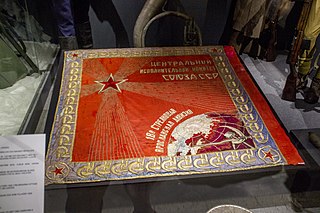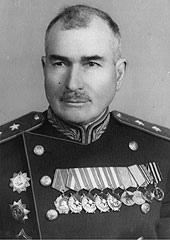
The 7th Army was a Soviet Red Army field army during World War II, primarily against Finland. It was disbanded in 1944.
The 9th Army of the Soviet Union's Red Army was a Soviet field army, active from 1939 to 1943.
The 63rd Army was a field army established by the Soviet Union's Red Army during World War II.

The 51st Army was a field army of the Red Army that saw action against the Germans in World War II on both the southern and northern sectors of the front. The army participated in the Battle of the Kerch Peninsula between December 1941 and January 1942; it was destroyed in May 1942 with other Soviet forces when the Wehrmacht launched an operation to dislodge them from the peninsula. The army fought in the Battle of Stalingrad during the winter of 1942–43, helping to defeat German relief attempts. From late 1944 to the end of the war, the army fought in the final cutting-off of German forces in the Courland area next to the Baltic. Inactivated in 1945, the army was activated again in 1977 to secure Sakhalin and the Kuril Islands. Following the dissolution of the Soviet Union, the army continued in existence as a component of the Russian Ground Forces. The army was active during two periods from 1941 until 1997.
The 26th Army was a field army of the Soviet Union's Red Army, active from 1941.

The 28th Army was a field army of the Red Army and the Soviet Ground Forces, formed three times in 1941–42 and active during the postwar period for many years in the Belorussian Military District.
The 95th Rifle Division was a Red Army Rifle Division during World War II, formed three times. The division was first formed in November 1923 with the 6th Rifle Corps. It fought in the Winter War and the Soviet occupation of Bessarabia and Northern Bukovina. After Operation Barbarossa, the division fought in the retreat from Moldova and fought in the siege of Odessa and the siege of Sevastopol. It was destroyed during the siege of Sevastopol and was disbanded in late July 1942. The division was reformed in August 1942 from the 13th Motor Rifle Division NKVD and fought at the Battle of Stalingrad. For its actions during the battle, the division became the 75th Guards Rifle Division in March 1943. In April 1943, the division was formed a third time at Kaluga from the 121st Rifle Brigade. It fought in Operation Bagration.
The 316th Rifle Division was formed as a Red Army division during World War II. The division was initially formed in July 1941, renamed the 8th Guards Rifle Division on 18 November 1941. The division was recreated at Vjasniki in July 1942, fought in the early battles around Stalingrad and was disbanded in November 1942. The division was recreated for the third time from the 57th and 131st Rifle Brigades in September 1943. The division ended the war assigned to the 27th Army of the 3rd Ukrainian Front.

The 308th Rifle Division was a rifle division of the Soviet Red Army during World War II. The division was formed three separate times during the course of the war.
The 266th Rifle Division was a rifle division of the Soviet Red Army during World War II. The 266th was formed three times during the war.

The 18th Rifle Division was an infantry division of the Soviet Union's Red Army during the Russian Civil War, Polish–Soviet War, Winter War and World War II. The division was formed a total of five times during this period.
The 46th Army was a Soviet Red Army field army during World War II. The army was formed in August 1941 and guarded the Turkish border. During the summer of 1942, it fought in the Battle of the Caucasus. During the spring of 1943, the army helped capture Maykop and Krasnodar. During the summer of 1943, it fought in the Donbass Strategic Offensive and the Battle of the Dnieper. During early 1944, it fought in the Nikopol–Krivoi Rog Offensive and the Odessa Offensive. During the summer it fought in the Second Jassy–Kishinev Offensive. The army advanced westward and participated in the Battle of Debrecen and Budapest Offensive during the fall. After the fall of Budapest in February 1945, the army fought in the Vienna Offensive and the Prague Offensive. During the summer of 1945, the army moved to the Odessa Military District and was disbanded in September.
The 31st Army was a field army of the Red Army during the Second World War.

The 32nd Army was a formation of the Soviet Army during World War II. The army was formed twice during the war, disbanded as part of the post-war demobilization and then reformed in 1969 to protect the Soviet-Chinese border.
The 70th Army was a Soviet field army during World War II. It was the highest-numbered combined arms army to be formed by the Stavka during the war. It was active at the Battle of Kursk, the Lublin–Brest Offensive, and the Berlin Strategic Offensive, among other actions.

The 5th Shock Army was a Red Army field army of World War II. The army was formed on 9 December 1942 by redesignating the 10th Reserve Army. The army was formed two times prior to this with neither formation lasting more than a month before being redesignated.
The 34th Army was part of the Red Army during the Second World War. The army was formed on 16 July 1941 in the Moscow Military District.
The 207th Rifle Division began its combat path under unusual circumstances. It was partly formed for the first time as a standard Red Army rifle division in the spring of 1941, before the German invasion, but was never completed. A second formation began in April 1942 and was completed on June 1, after which it was sent to the Stalingrad Front. Heavily depleted in counterattacks against the north flank of German Sixth Army, by November the survivors were reassigned and the division disbanded. The 207th was formed for a third time in June 1943, and fought its way through the central part of the Soviet-German front, ending the war in the heart of Berlin in the battle for the Reichstag. The division saw postwar service in the Group of Soviet Forces in Germany.
The 1st Guards Tank Division was a tank division of the Soviet Army from 1945 to 1947, stationed in Neuruppin. It was formed in the spring of 1942 as the 26th Tank Corps. The corps fought in Operation Uranus and became the 1st Guards Tank Corps, being redesignated as a reward for its actions in December 1942. It fought in Operation Gallop, the Third Battle of Kharkov, Operation Kutuzov, Operation Bagration, the East Prussian Offensive, the East Pomeranian Offensive and the Berlin Offensive. During the East Prussian Offensive, the division captured Mława, Działdowo and Płońsk and was awarded the Order of Lenin for its actions. The division had been awarded the honorific "Don" for its actions in Operation Gallop. It also was awarded the Order of the Red Banner and the Order of Suvorov 2nd class.

Aleksei Aleksandrovich Grechkin was a Soviet army commander.







